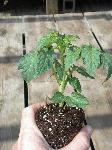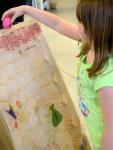BLUE SPRINGS, Mo. – A fundamental and often overlooked decision in planting a garden is whether to directly seed a crop into the soil or to place transplants of a crop into the garden, says a University of Missouri Extension horticulturist.
“Gardeners typically let this decision to be made for them,” says Marlin Bates. “If transplants of a particular crop are available, it’s easy to assume that transplanting is the preferred method of placing that crop in the garden. While this may be true for most crops that are available as transplants, it’s not always the case.”
There are many benefits to placing transplants in the garden, particularly the head start that plants get from growing in a controlled environment for several weeks, Bates said. But gardeners should realize that some crops do not tolerate being transplanted very well. This means that the benefit of the head start may be lost and the plant is not likely to perform well during the season. For these crops it is not only more economical but also more successful to sow seed directly in the garden after soil temperatures have warmed sufficiently for that crop.
Just as surely as some crops perform best when directly seeded into the garden, there are some crops that benefit from being transplanted into the garden.
“Some vegetable seeds simply do not germinate uniformly, so transplant production of these crops lets the gardener select the best seedlings to grow on,” Bates said.
Additionally, many warm-season vegetable seeds need relatively high soil temperatures to germinate and are slow to establish, so there may be up to a four- to six-week head start on production when you place these crops in the garden as transplants, he said. Conversely, warm-season plants that germinate and grow quickly often aren’t worth the added investment of transplanting.
Use this chart to help decide which plants to direct seed or transplant into the garden:
|
Direct Seed
|
Transplant
|
|
Beans
Beets
Cilantro
Carrot
Collards
Dill
Sweet Corn
Cucumber
Gourds
Kale
Kohlrabi
Leaf Lettuce
Melons
Okra
Peas
Pumpkin
Radish
Spinach
Squash
Swiss Chard
Turnip
|
Basil
Broccoli
Brussels Sprouts
Cabbage
Cauliflower
Celery
Chinese Cabbage
Eggplant
Leeks
Mint
Oregano
Peppers
Rosemary
Sage
Tomatillo
Tomato
|
As the table demonstrates, more vegetables should be direct-seeded than should be transplanted into the garden. This is not an all-inclusive list, and some plants may achieve best performance with different planting methods depending on season, Bates said. For example, broccoli, Brussels sprouts, cabbage and cauliflower should be direct-seeded in midsummer for a fall crop, but they benefit from being transplanted in the spring for an early crop.
Dollar-for-dollar, direct seeding may yield a larger harvest unless gardeners are good at producing their own transplants. However, it is worth the added cost of purchasing—or the extra work of producing—transplants to obtain good, healthy stock of certain garden vegetables to place into the garden.
Read more http://extension.missouri.edu/news/DisplayStory.aspx?N=1396






